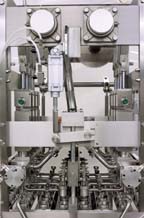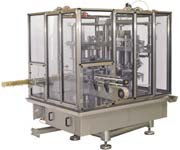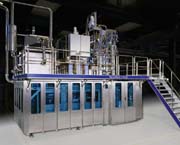IT’S A GAME OF SPACE, VARIETY AND RAPID ORDER FULFILLMENT. That’s the retail side of the packaged food business today. On the manufacturing side, the game translates into flexibility, changeover, and mass customization.
Today’s food manufacturers require highly flexible machinery that can fill different volumes and types of products into a wide range of package sizes. Rapid changeover, with little or no tool requirements, is imperative. Replicating filling and other production settings should require little more than a screen touch.

Aseptic wave
The changing mix of demanding retailers has also opened doors to innovative adaptations of existing technology. For example, aseptic technology has hovered over the American food manufacturing industry since the early 1980s, proving its utility in numerous market niches. Yet aseptic has never taken hold in the U.S. market in the same way it has dominated other international markets, including Europe and South America.But the proliferation of new retail channels has strained the limits of other packaging systems and nearly demanded that aseptic systems, old and new, step up and answer the call.
“The convenience store, the dollar store, new mass merchandisers, the vending business and other evolving retail outlets have exposed the limits of where some products can go,” says Jeff Kellar, vice president strategic business development for Tetra Pak. Refrigerated products are expensive to hold in the limited refrigerated storage space of most retailers. “Many of those products have required refrigeration. We’re seeing growth opportunities for carton technology plus newly evolved plastic packaging technologies. Some of the latest advances provide different functional or branding opportunities to customers.”
Specialty franchises like Starbucks have also opened opportunities for manufacturers. Horizon Organic saw an opportunity to expand its line by offering the successful coffee franchiser a much-needed business opportunity.
“Starbucks wanted to complement its beverage offerings, which were aimed almost entirely at adults, with something for kids,” explains Kellar, pointing out that today’s consumers expect to find products wherever and whenever they want them. “The stores do not have a huge refrigerated storage place. What more logical product to offer than flavored milks? The company provided Starbucks with an ambient solution. Yes, the product is sold chilled. But the stores can keep it in the back room until they are ready to put it in the refrigerated case for sale.”
What enabled this solution was the Tetra Plast LFA-20 aseptic filling technology. The growth of the carbonated soft drink market has slowed considerably in recent years, opening numerous opportunities for innovative beverages. The first company to use the filler was Dr Pepper/7Up on Raging Cow, a dairy-based beverage packaged in an aseptic six-layer HDPE bottle with an innovative sport-like closure named Bebop. The HDPE bottles are lighter and allow more flexible bottle shapes, sizes and designs. Thus, they offer better product differentiation and corresponding branding opportunities.
The Tetra Plast LFA-20 marks the first time that low-acid products such as infant formulas, flavored milk, nutritional drinks, and certain prepared foods can be run in plastic containers at a commercial filling speed. Key to the system is the gas hydrogen peroxide sterilization system, which can sterilize almost any container, regardless of shape. Another significant feature of the system is a patented sealing technology that provides a reliable induction hermetic seal. The system also eliminates bottle jams with a linear carriage system that retains bottles within the carrier throughout the filling cycle.
Last year, another Tetra Pak innovation, Tetra Recart, received DuPont Diamond Award recognition. The high speed filling technology fills retortable fiberboard cartons at speeds up to 24,000 cartons per hour.
Tetra Pak will unveil other breakthrough technologies in 2004. New Glastic high-barrier see-through film will employ ultra-sonic sealing technology that will enable production of clear Tetra Brik aseptic packages. The system adds a silicone dioxide barrier layer to a PET film structure and eliminates the need for the aluminum lining that has characterized the Tetra Brik package for an entire generation.

New designs
FMC FoodTech has updated its line of FranRica bulk aseptic fillers and sterilizers. Traditionally used on tomato products, the most recent generation of FranRica’s aseptic bag fillers features a new stemless fill tube design that reduces tomato dice degradation. Created through a joint venture between FMC’s Parma, Italy, and Madeira, Calif., units, the system will also fill tomato paste.Hassia counts its Steam Aseptic System as its latest success. Steam sterilization allows the creation of sterile shelf-stable packaged food products without the use of chemicals.
A new Product Transfer Shuttle from Heat and Control, Hayward, Calif., boosts accuracy in product weighing. It employs an Ishida multi-head weigher at multiple fill positions on intermittent motion packaging equipment. Designed to fill packages of meat, poultry, cheese and seafood, the shuttle may be used on horizontal thermoformers and tray/cartoning lines. Easy, “no-tools” changeover characteristics allow quick conversion to different configurations for various package sizes.
Unifiller is FMC FoodTech’s latest high-accuracy filler for viscous and milk-type products, including infant formula, health drinks, and chocolate, cocoa and coffee drinks. Unlike conventional plug-type fillers, this state-of-the-art piston filler design has no seals in the fill station. Highly accurate machining, coupled with the absence of seals, eliminates air bubble formation and other common causes of fill-weight variation. The unit’s vertically actuated valve concept leaves a minimum of residual product in the cylinder. The filler operates at speeds up to 1000 cans per minute in both standard and 3-A applications. It can be cleaned in place without disassembly of the fill stations. Complete changeover can be conducted in less than 10 minutes.
“All the base parts of our machines are interchangeable,” points out Jan Sundberg, applications engineer and project manager for FMC FoodTech’s food processing division. “A manufacturer that has both a piston filler and a granular filler from FMC has fewer parts to hold.”
Other upgrades to the FMC FoodTech line include a “no can, no fill” feature on the XL Piston Filler. “We are also doing feedback controls for checkweighers,” says Sundberg. “An automatic fill feature addresses variations in fill weights.”
FMC FoodTech’s Vacuum Filler is used on tuna lines as well as in diced and whole-peeled tomato lines. The unit features a lifter plate that elevates the container and seals it from the atmosphere, creating a vacuum that draws product into the container. “It is ideal under conditions in which product may develop air pockets, yet you still need good line speed,” says Sundberg. “The Vacuum Filler always leaves precise head space.”
Another significant FMC FoodTech advance is TwinTec, which entered the European market this past year. A mono-block, single-base unit, it combines filler and seamer into a single machine. Featuring a single sanitary base, one control system, one drive and one lubrication system, TwinTec eliminates the need for two machines along with the accruing complications of synchronization. Although its first application was on a vacuum filler, TwinTec can also incorporate other FMC FoodTech fillers. The smaller footprint of the combined system also offers a distinct advantage, particularly on a tight manufacturing floor.
The Net/Mass Net Weight liquid filling system from Oden Corp. is a Coriolis mass meter-based liquid filler. It is designed for products that may change viscosity over the course of a filling run or from batch to batch. The mass meter senses the density of the product, and can make filling adjustments on the fly.
“It’s a smart device,” explains Oden’s Vice President of Sales Gary Laidman. “Every single weight is stored in memory. Every product density is captured by the system. You can see exactly what went into every can at the end of the run.”
The value of system software has become as important as the hardware in today’s food processing world, Laidman believes. The ability to replicate equipment settings and adjustments for a wide variety of products and packages at the push of a button is an invaluable trait in fillers and other food equipment today.
Of equal importance is rapid changeover with minimal tool and time requirement. Oden’s Servo/Fill Volumetric liquid filling systems are described as “microprocessor controlled, servo-driven, rotary motion sanitary gear pump, positive displacement liquid fillers.” They are available as benchtop, fully automatic in-line systems or fully automatic frame-based in-line systems.
“We have built around the servo-control rotary-based positive displacement pump system,” says Laidman. “With it, you can fill containers ranging from one-ounce to five gallons on a single machine.”

Servo-driven CIP
Autoprod, Inc., Clearwater, Fla., which manufactures rotary and in-line preformed cup filling systems, CIP/SIP filling technology, and MAP and hot-pack filling systems, offers new servo-driven CIP fillers. The systems are separated from the primary machine drive, allowing operators to work on the rest of the machine during its CIP cleaning cycle. The easy-to-operate, push-button servo-driven CIP system requires no mechanical setup. Operators can also store product parameters to optimize machine productivity and run machines at the highest possible efficiency.“The new technology used on our CIP fillers enables longer runs between cleaning cycles,” notes Tom Zopf, sales manager. “A processor can run for 40 hours straight on some dairy products. This cuts downtime and improves cleaning efficiency.”
Zopf also points to improved accuracy on the Autoprod filler line. “A new piston design results in better accuracy, longer runs, more reliable components.”
He also notes that simplicity has become a most desirable trait on filling equipment.
“We’re working on new filling technologies that provide larger filling lines with fewer moving parts,” says Zopf. Among other objectives are: longer runs for increased line efficiency; higher reliability and decreased maintenance on internal parts; higher hygienic levels for increased runs between cleaning cycles; and improved automation for easier operation and efficiency.

Sanitary design
New sanitary designs continue to evolve to insure food product quality and safety. Fogg Filler, Holland, Mich., has introduced a new sanitary valve designed for non-contact, extended shelf life applications. Its “Untouchable” metered filling valve series is designed for ultra-clean and extended shelf-life products. Designed without O-rings that can harbor bacteria, the “Untouchable” attempts to eliminate bacterial contamination by not allowing the valve to come into contact with the bottle. Operating electronically, it promises accurate and sanitary filling regardless of line speed, container size, or neck style. Used in an extended shelf life enclosure, it allows easy rinsing of filling plumbing without compromising the HEPA seal. It can be used with a wide range of products including viscous liquids, and hot- and cold-pack products.Fogg’s new Fill-Pro 5000 Series filling system for liquid products incorporates a number of new technologies. Designed to add filling flexibility, the Fill-Pro 5000 offers both gravity and metered filling options. The latter option is available for extended shelf-life (ESL) products or viscous products. A hepa filter system can be added for ESL products. Fill-Pro works in both cold and hot-fill applications.
An adjustable timing screw, driven by a timing belt, controls bottle feed. The system is designed for easy changeover and maintenance. The system also incorporates the Fogg 700 Series screw capping system, regarded by the manufacturer as state-of-the-art. All settings on the Fogg Fill Pro 5000 can be performed on a touch-screen control panel.
Expect the coming generation of fillers to offer even more simplified designs for easy changeover, maintenance and programmable settings. As the engineering burden has shifted from the manufacturer to off-the-shelf and custom-design machines, food processors have seen equipment manufacturers come to the rescue. The sophistication of today’s fillers and up- and downstream technologies has improved dramatically.
For more information:
Tom Zopf 727-572-7753;
www.autoprodinc.com
FMC FoodTech, Rob Cherry,
559-661-3205;
rob.cherry@fmcti.com or fmcfoodtech.info@fmcti.com; www.fmcfoodtech.com
Chip Mazurek, 616-786-3644; www.foggfiller.com
Charles Ravalli, 732-208-3537;
hassiaus@aol.com;
www.hassia.com
Dave McAlpin, 510-259-0500;
davem@heatandcontrol.com; www.heatandcontrol.com
Jeff Kellar, 847-955-6000;
infomedia.us@tetrapak.com;
www.tetrapakusa.com
Gary Laidman, 800-658-3622;
www.odencorp.com